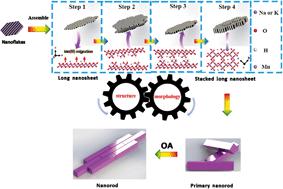当前位置:
X-MOL 学术
›
Environ. Sci.: Nano
›
论文详情
Our official English website, www.x-mol.net, welcomes your
feedback! (Note: you will need to create a separate account there.)
Coupled morphological and structural evolution of δ-MnO2 to α-MnO2 through multistage oriented assembly processes: the role of Mn(III)
Environmental Science: Nano ( IF 5.8 ) Pub Date : 2019-11-21 , DOI: 10.1039/c9en01000a Xinran Liang 1, 2, 3, 4, 5 , Jeffrey E. Post 6, 7, 8, 9 , Bruno Lanson 10, 11, 12, 13, 14 , Xiaoming Wang 1, 2, 3, 4, 5 , Mengqiang Zhu 9, 15, 16, 17 , Fan Liu 1, 2, 3, 4, 5 , Wenfeng Tan 1, 2, 3, 4, 5 , Xionghan Feng 1, 2, 3, 4, 5 , Guomin Zhu 9, 18, 19, 20 , Xin Zhang 9, 18, 19, 20 , James. J. De Yoreo 9, 18, 19, 20
Environmental Science: Nano ( IF 5.8 ) Pub Date : 2019-11-21 , DOI: 10.1039/c9en01000a Xinran Liang 1, 2, 3, 4, 5 , Jeffrey E. Post 6, 7, 8, 9 , Bruno Lanson 10, 11, 12, 13, 14 , Xiaoming Wang 1, 2, 3, 4, 5 , Mengqiang Zhu 9, 15, 16, 17 , Fan Liu 1, 2, 3, 4, 5 , Wenfeng Tan 1, 2, 3, 4, 5 , Xionghan Feng 1, 2, 3, 4, 5 , Guomin Zhu 9, 18, 19, 20 , Xin Zhang 9, 18, 19, 20 , James. J. De Yoreo 9, 18, 19, 20
Affiliation

|
α-MnO2 is a typical tunneled Mn oxide (TMO) that is frequently associated with δ-MnO2 in the environment and exhibits strong adsorption and oxidation activity. The morphology of α-MnO2, which is controlled by an oriented attachment (OA) process, is one of the key factors affecting its reactivity. However, the detailed crystal growth process and coupling between morphology and structure of α-MnO2 during OA processes remain poorly understood. We propose that the transformation of layer-based δ-MnO2 to tunnel-based α-MnO2 occurs via a multistage OA process. In the initial stage, the produced δ-MnO2 nanoflakes are found to spontaneously self-assemble into a nanoribbon with a large number of lattice defects via edge-to-edge OA. The presence of lattice defects promotes the generation of oxygen vacancies, and the Mn(IV) ions in the [MnO6] octahedral layers of δ-MnO2 are reduced to Mn(III)/Mn(II). The reduced ions subsequently migrate from the [MnO6] octahedral layers to the interlayers during this process. The hydroxide which acts in coordination with the interlayer Mn(III)/Mn(II) and oxygen atoms coordination with adjacent nanoribbons attach to each other driven by hydrogen bonding and form primary nanorods through a face-to-face OA mechanism along the c-axis. Concomitantly, the bonding of [Mn(III)O6] octahedra in the interlayer of the nanoribbons with adjacent [MnO6] octahedral layers leads to the fabrication of a new α-MnO2 tunnel structure from the original δ-MnO2. These findings provide insights into both the transformation mechanisms of the layer-based to the tunnel-based nanoparticles and methods for the efficient and controlled synthesis of nanomaterials.
中文翻译:

通过多阶段定向组装过程将δ-MnO2的形态和结构耦合耦合:Mn(III)的作用
α-MnO的2是与δ-MnO的频繁相关联的典型隧道Mn氧化物(TMO)2在环境并显示出很强的吸附和氧化活性。α-MnO的形态2,它是由一种面向连接(OA)过程的控制,是影响其反应性的关键因素之一。然而,详细的晶体生长工艺和形态和α-MnO的结构之间的偶联2期间OA过程仍然知之甚少。我们建议,基于层δ-MnO的改造2至基于隧道的α-MnO的2发生经由多级OA过程。在初始阶段,所产生的δ-的MnO 2发现纳米薄片通过边到边的OA自发地自组装成具有大量晶格缺陷的纳米带。晶格缺陷的存在促进氧空位的产生,并且将Mn(IV)中的离子[MnO的6 ]δ-的MnO八面体层2被还原成锰(III)/锰(II)。还原的离子随后在此过程中从[MnO 6 ]八面体层迁移到中间层。与中间层Mn(III)/ Mn(II)协同作用的氢氧化物)和氧原子与相邻纳米带的配位在氢键的驱动下相互连接,并通过沿c轴的面对面OA机理形成一级纳米棒。伴随地,的[锰(接合III)O 6 ]八面体在纳米带的层间与相邻的[MnO的6 ]八面体层导致一个新的α-MnO的的制造2隧道结构从原来的δ-的MnO 2。这些发现为从层到隧道的纳米颗粒的转变机理以及有效和受控地合成纳米材料的方法提供了见识。
更新日期:2019-11-21
中文翻译:

通过多阶段定向组装过程将δ-MnO2的形态和结构耦合耦合:Mn(III)的作用
α-MnO的2是与δ-MnO的频繁相关联的典型隧道Mn氧化物(TMO)2在环境并显示出很强的吸附和氧化活性。α-MnO的形态2,它是由一种面向连接(OA)过程的控制,是影响其反应性的关键因素之一。然而,详细的晶体生长工艺和形态和α-MnO的结构之间的偶联2期间OA过程仍然知之甚少。我们建议,基于层δ-MnO的改造2至基于隧道的α-MnO的2发生经由多级OA过程。在初始阶段,所产生的δ-的MnO 2发现纳米薄片通过边到边的OA自发地自组装成具有大量晶格缺陷的纳米带。晶格缺陷的存在促进氧空位的产生,并且将Mn(IV)中的离子[MnO的6 ]δ-的MnO八面体层2被还原成锰(III)/锰(II)。还原的离子随后在此过程中从[MnO 6 ]八面体层迁移到中间层。与中间层Mn(III)/ Mn(II)协同作用的氢氧化物)和氧原子与相邻纳米带的配位在氢键的驱动下相互连接,并通过沿c轴的面对面OA机理形成一级纳米棒。伴随地,的[锰(接合III)O 6 ]八面体在纳米带的层间与相邻的[MnO的6 ]八面体层导致一个新的α-MnO的的制造2隧道结构从原来的δ-的MnO 2。这些发现为从层到隧道的纳米颗粒的转变机理以及有效和受控地合成纳米材料的方法提供了见识。











































 京公网安备 11010802027423号
京公网安备 11010802027423号